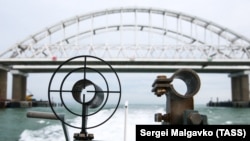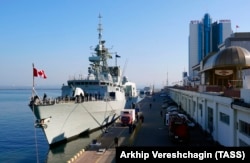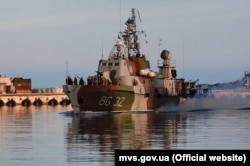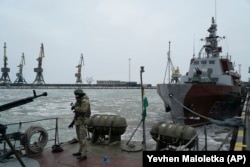On Tuesday, April 2, the United States Permanent Representative to NATO, Kay Bailey Hutchison, said that the military alliance is working on a package that “beefs up” air surveillance and “the number of NATO country ships going into the Black Sea to assure that there’s a safe passage for Ukrainian vessels through the Kerch Strait – the Sea of Azov.”
She said the point of those measures would be to assure that the waters are “cleared” and to that assure countries in and around the Black Sea “are safe from Russian meddling.”
"Russia is putting defensive weapons in Crimea – Crimea is part of Ukraine, and it is very important that Romania, Bulgaria, and Ukraine, as well as Georgia, have the security in that Black Sea area both for ships but also for their land-based safety," Hutchison said.
The package was approved during a two-day meeting of NATO Foreign Ministers in Washington DC that began on Wednesday, April 3. NATO Secretary General Jens Stoltenberg said the idea is to improve NATO's "situational awareness" in the Black Sea region.
"Right now, one of NATO’s naval groups is on patrol in the Black Sea. And today, it is exercising with Ukrainian and Georgian ships," Stoltenberg told reporters on April 4.
Russian presidential spokesman Dmitry Peskov said the Kremlin had taken Hutchison’s announcement in “a negative light,” adding “we do not understand what it means."
Russian State Duma deputy of the Republic of Crimea, Ruslan Balbek, however, offered a more strongly-worded response:
“As for the passage of the Ukrainian ships through the Kerch Strait ... no matter how much NATO beats its chest, the ships will pass through it only in accordance with Russian rules, and not anybody else’s. Let NATO launch even half of its fleet into the Black Sea.”
Franz Klintsevich, a member of the Federation Council’s Committee on Defense and Security, called the potential of U.S. vessels accompanying Ukrainian ships through the Kerch Strait a “provocation.”
“If you are trying to arrange a provocation, based on the idea that Crimea is not ours and without complying with international norms, you will be attempting to break through the border of the Russian Federation, all of which will be harshly suppressed, whether we are talking about Ukrainian, American or any other ships,” he said.
Klintsevich added that the United States can be present in the Black Sea in accordance with existing agreements, “no more and no less.”
In any case, his attempts to both appeal to international norms at a time when Russia has unilaterally redefined Ukraine’s borders is contradictory.
The Kerch Strait became a point of contention in November 2018 after Russian Coast Guard boats rammed a Ukrainian tugboat on its way to transit the Kerch Strait from the Black Sea into the Sea of Azov, between Russia and Russian-occupied Crimea. The incident ended with Russian vessels firing on two Ukrainian naval patrol boats that came to the aid of the tug, and Russian forces capturing all three Ukrainian vessels along with their crews.
Speaking at the Atlantic Council in Washington last October, the head of the U.S. Navy forces in Europe, Adm. James Foggo, said that as an inland, semi-enclosed body of water, the Sea of Azov is governed by Article 123 of the United Nations Convention on the Law of the Sea (UNCLOS).
Article 19 of UNCLOS allows foreign ships, even military vessels, to pass through the territorial waters of another state so long as that passage is “not prejudicial to the peace, good order or security of the coastal state.”
But international law in regards to navigating the Kerch Straight and the Sea of Azov have been complicated by Russia’s 2014 annexation of the Crimean peninsula.
Vladimir Socor of the Jamestown Foundation wrote that to the extent any legal status for the Sea of Azov and Kerch Strait even exists, “it is murky.”
Socor said that legal status was codified in the “treaty on cooperation between the Russian Federation and Ukraine on the use of the Azov Sea and Kerch Strait,” which was signed in December 2003 and ratified by both parliaments the following April.
Socor said this treaty defines the Sea of Azov and Kerch Strait as “historically internal” waters of the Russian Federation and Ukraine, noting that the qualifier “historically internal” is meant to emphasize that they have never had international status.
He said that while Russia has cited this treaty to justify its use of force in the two bodies of water, it unilaterally overturned the agreement following the annexation of Crimea.
Socor noted glaring omissions in that treaty, including the fact that it makes “no reference to general international law, nor to the United Nations Convention on the Law of the Sea.”
Mykhailo Samus, deputy director for international issues at Ukraine’s non-governmental Center for Army, Conversion and Disarmament Studies, argued that Russia has “consistently intended to create conditions for the Sea of Azov to be classified as an inland sea,” whereby the norms of international maritime law would not apply.
But as no separate delimitation deal determining the borders of the Sea of Azov were ever finalized, Samus says a legal vacuum was created which “allows Russia to freely interpret and independently determine such borders.”
And following the annexation of Crimea, he says Russia no longer acts as if the Sea of Azov is an inland sea of Ukraine and Russia, but strictly a Russian sea.
Günther Handl, a professor of international law at Tulane University, told Polygraph.info that arguing Crimea is Russian land is “a reflection of the status quo in practical terms,” in so far as “might makes right.”
Legally, however, Russia’s position is dubious.
“Formally speaking [Klintsevich’s position] is incorrect because Russia’s right to Crimea has not been recognized. Crimea is recognized as Ukrainian,” he said, adding Ukraine is essentially moving through its own internal waters when traversing the Sea of Azov and Kerch Strait.
And as the Sea of Azov connects with “another body of high seas water,” Handl said both sides qualify for innocent passage.
But even then, Handl said the legal status of Crimea could be immaterial, as the regime of innocent passage or transit passage should apply, making any Russian attempts to police the waters illegal.
“There is no right for costal state(s) to take any action whatsoever at sea … military vessels can go through in normal formations [and] planes could be taking off and landing while transiting through the international straight,” he said.
But Handl said he would be surprised if NATO “tried to project forces into the area.”
And while the status of the Sea of Azov and Kerch Strait remains murky, United Nations General Assembly adopted Resolution 68/262, found no basis for “any alteration of the status of the Autonomous Republic of Crimea or of the city of Sevastopol,” nullifying any attempts by Russia to treat the Sea of Azov as a strictly Russian sea.
Polygraph.info finds Klintsevich’s assumption that the waters surrounding Crimea are an extension of the Russian Federation is false.









